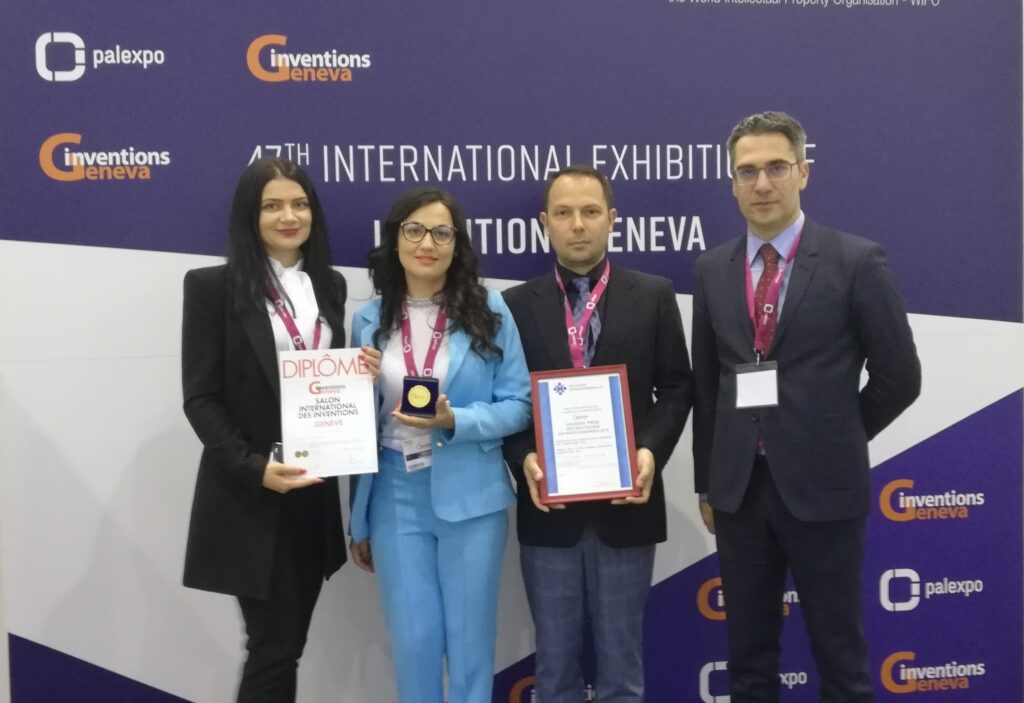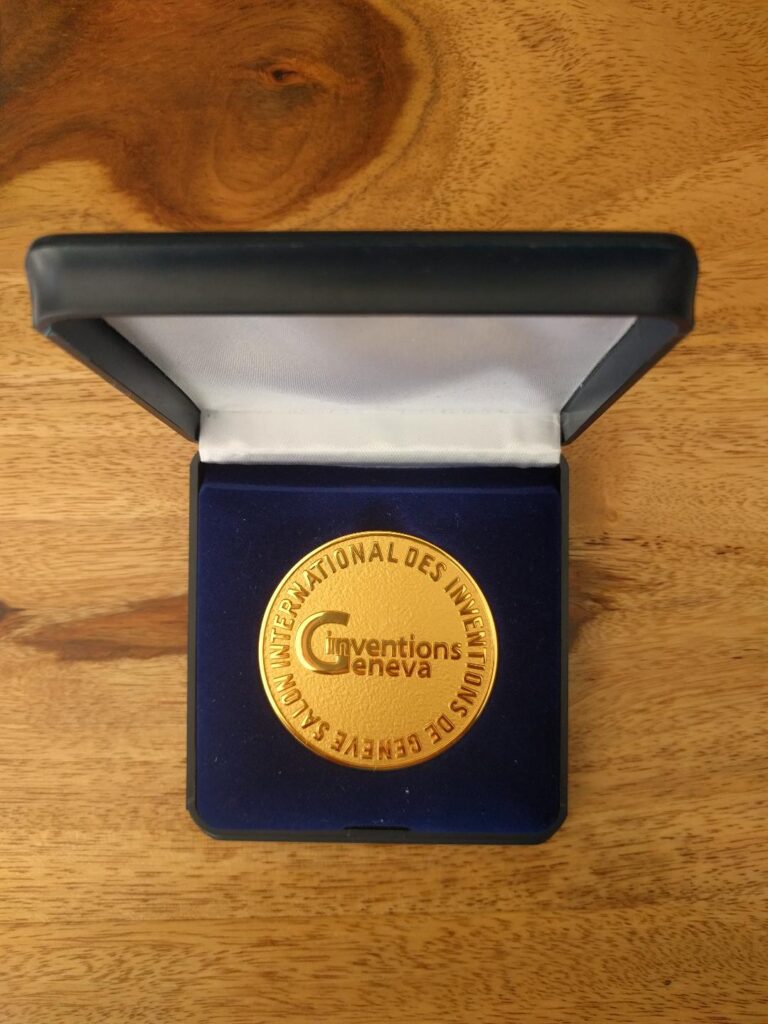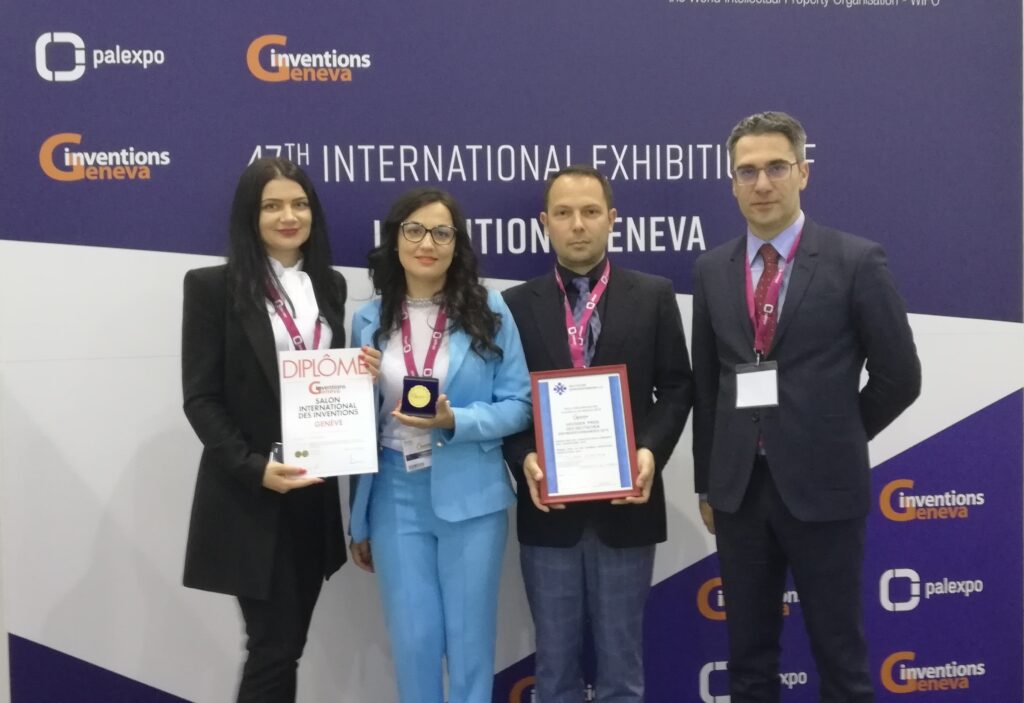A painter and restorer from Cluj has been awarded the gold medal at the International Exhibition of Inventions in Geneva 2019 for an extraordinary invention, an Alphabet of Colors for the Visually Impaired called the Scripor Alphabet, named after the inventor Tudor Scripor.
As an expert in art, restoration, and icon painting, Scripor worked for 7 years to find a way to make the visually impaired “feel” colors.
His name seems to be destined for this endeavor. “Script” comes from the Latin word “scribere,” meaning “to write” using a specific alphabet.
The alphabet he invented transforms a disability into a super ability and will give visually impaired individuals independence, hope, freedom, and creativity to express themselves.
“It all started in 2012 during a painting course. I teach painting and restoration techniques. I had a visually impaired student who enrolled in my course, and it was quite challenging to communicate the language of colors to him, especially in terms of chromatics. I explained to him volumetrically how a painting looks, but I realized that it was not enough because when we look at a painting, our eyes see colors, and colors convey a certain emotion, which I couldn’t achieve with this student.
Since then, I set out to discover a connection between colors and the world of the visually impaired. I searched everything possible on the internet and found that there were only failed attempts related to this desire. Through extensive study and research, I reached the beginning of the project and discovered that the visually impaired dream in colors. That’s where it all started, and together with a group of visually impaired volunteers, we embarked on this premise that they dream in colors. They told me, and there are also studies on this subject. We also started from the fact that they can associate colors with certain sensations: red with the sensation of warmth, expansion, and blue with the sensation of cold. We associated geometric shapes, such as the circle, rectangle, and square, with the primary colors, namely red with warmth and the circle, yellow with the rectangle, and blue with the square, representing the sensation of cold.”
By overlapping these geometric and chromatic shapes, secondary colors and secondary geometric shapes were obtained. These were taken and simplified, introduced into a matrix of 9 points, plus an orientation point, resulting in a tactile language. Essentially, we have two alphabets: one for shapes and colors, and the other for colors and points, an extension of the Braille alphabet. The difference was that visually impaired individuals had 6 points for letters and numbers, and now for colors, they have nine points, which maintain the same size and dimensions as the Braille alphabet. It was very easy for them to understand, especially for those who have been using Braille,” explained Tudor Scripor.
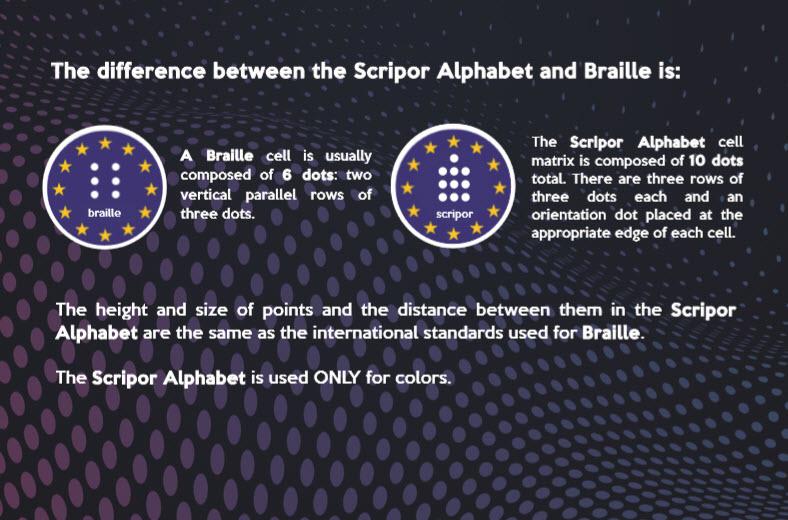
The new color alphabet consists of 9 main points and an orientation point. “The alphabet I invented also includes a top point for orientation. For example, these symbols will be placed on a paint can, and this point will help them know where the lid is, or on pencils, and they will know where the tip is, or on clothing labels, and they will find the top position.
We focused a lot on the emotional aspect, and now with this alphabet, we hope to give them a greater degree of independence. Visually impaired individuals are taught to buy only white, black, gray, and red-colored clothes because no matter how they combine these clothes, they cannot go wrong. Can you imagine how frustrating it is for a young person who became visually impaired during adolescence to no longer be able to easily find the clothes they want?” emphasized the inventor from Cluj.
Where have we gone wrong so far?
“Most of those who have tried to create such an alphabet have been visually impaired themselves. They each made their own legend. For example, they would use lines for one color, sharp lines for another color, dots for another color, but that language was individual and couldn’t be universally adopted because it had no logic, no universal basis.
It helped me that I had the subjects I worked with. I am also an artist and have experience in mathematics and geometry, and from there, I could make all these connections. This alphabet is a combination of other fields. No visually impaired person can create such an alphabet because they don’t have the perception of colors. The best example is Louis Braille, who had sight but became blind during his life and invented the Braille alphabet,” added Tudor Scripor.
The Scripor Alphabet can be used in all aspects of life, from choosing a simple pair of bright red pants without the visually impaired person needing assistance or asking the salesperson, to participating in a card game with friends or family, and even understanding the colors in a work of art.
“We want to create a lot of toys for visually impaired individuals so that they can interact with a sighted family member and play games like cards or other games with color symbols. Essentially, we bring the visually impaired to a level of color perception equal to those who can see. It will help them in socialization because now the topic of colors is no longer closed off. They knew that colors existed in a virtual sense, but now it will help them in accessibility and social inclusion.
According to studies, most visually impaired individuals in the world have lost their sight during their lives due to accidents or illnesses. Very few, and their numbers are decreasing, are completely blind. There are 1.3 billion people with visual impairments, but only 36 million are completely blind.
What is very important is that this color code can also represent the intensity and the lighter or darker shade of a color. For example, pink. We know that it is a combination of red and white. By combining the symbols for the colors red and white, we get the color pink. If it’s a fluorescent green, by using a double symbol for green, we effectively double the color intensity. People in Geneva saw something extraordinary here because the Braille alphabet is difficult to learn, and it is specific to each language, but this color symbol is universal and cannot be translated. It is a universal language in India, China, Romania, the United States, and everywhere else. For blue, a person no longer needs to know how to write in a specific language; they only need one symbol, and for shades, they need two symbols.”
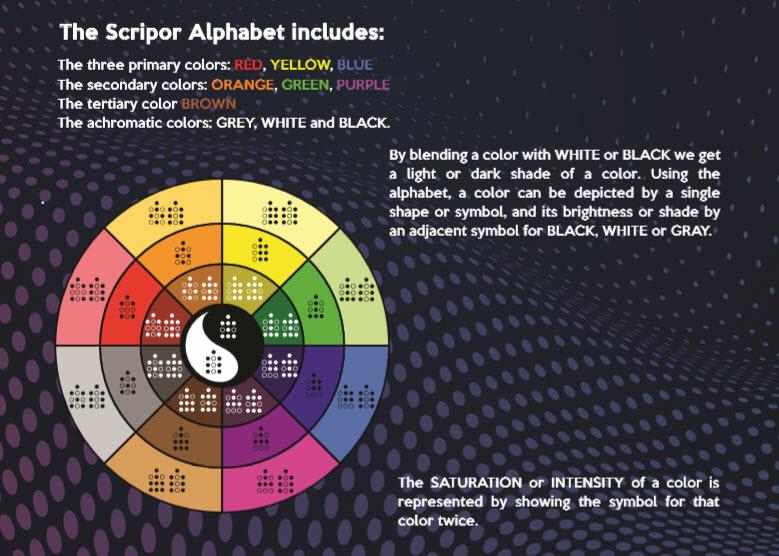
It can also be used in situations that we, as sighted individuals, wouldn’t even think of, such as on boxes of white or dark chocolate, beer bottles, white or red wine, and countless other situations.
Currently, there are all sorts of smartphone cameras on the market that are costly and do not accurately reproduce colors. In a country like India, I can’t go there with $5,000 glasses to teach children about colors. When you put the glasses towards a color, it audibly indicates what color it is, but no mental projection is created. What I have done means literacy and education,” added the inventor.
At Geneva, Tudor Scripor received the gold medal and a special award from the German Inventors Association.
“In Geneva, this alphabet was very well received, especially by people who work with individuals with disabilities. They said it is logical, intuitive, and easy to learn. I received the gold medal and a special award, which only 30 inventors out of those present receive. We received the special award from the German Inventors Association. They are very strict, and you have to convince them with all the arguments,” he added.
Tudor Scripor believes that the alphabet can be implemented very well in the education system as well as in private domains. “Now we are starting the implementation because we are in discussions with education ministries from several countries. We are starting with Romania, that is my wish. We are about to sign a protocol with UBB (Babeș-Bolyai University), but we also want to go to the USA, China, India, where they can use the symbols in schools.
There is also the possibility of using it in the Paralympics. Many visually impaired individuals participate in judo and contact sports. We want to implement it on national flags and on belts for kimonos.”
Additionally, Americans are interested in using it for interior design. There is also the possibility of using it for museum accessibility, as we can represent all the great masterpieces in a plan using color symbols. Until now, paintings for the visually impaired were represented as bas-reliefs, but bas-reliefs are another form of art, they are cold, they don’t convey emotion or color,” concluded Tudor Scripor.
The promotion of the Scripor Alphabet was also worked on by the team at Magnet Media.
“Our involvement in the Scripor Alphabet project was a challenge. Given the magnitude of the event we were going to participate in, the 2019 International Exhibition of Inventions in Geneva, the bar was set very high. We knew that we needed a creatively crafted campaign message to achieve our desired objective, which was to convey not only the genius of this invention but also the emotion behind it.
“COLORS IN DARKNESS” is the campaign message we chose to promote the Scripor Alphabet, and we associated it with a visually impactful image. The synergy between the two worked perfectly, and marketing paved the way for the innovation and emotion to reach the public, the jury, and ultimately, the Gold Medal.
The Scripor Alphabet is a Color Alphabet for the Visually Impaired named after its inventor, Tudor Scripor. This tactile color coding system allows the visually impaired to perceive colors. The applications of the Scripor Alphabet can be found in various fields, from medicine, industry, and technology to culture and education, visual arts, and architecture. With its help, individuals with total or partial visual impairment will enjoy perceptions in an area that has been “dark” until now. Genius, isn’t it?
We are honored to be part of the Scripor Alphabet team, winner of the Gold Medal in the “Art, Culture, and Education” category and the Grand Prize of the German Inventors Association at this year’s International Exhibition of Inventions in Geneva,” said Gabriel Chifa, Director of Magnet Media.
